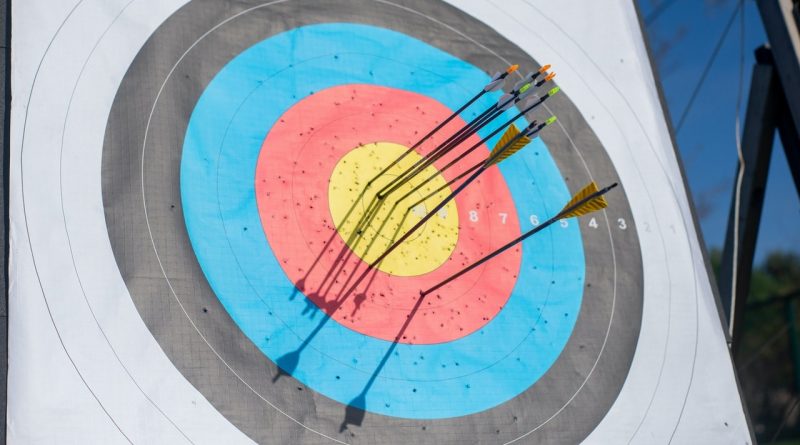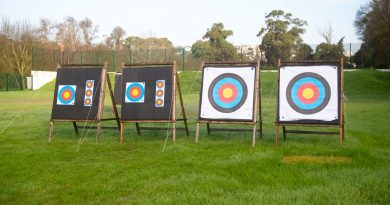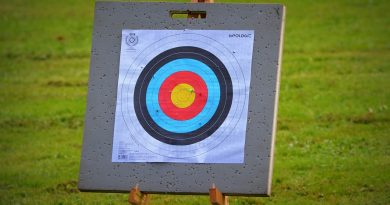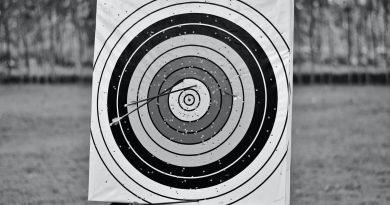The Bow Sight – Advantages and Limitations
Probably no single accessory has caused more discussion and controversy among archers than the bow sight. The modern archer was the first to adopt the principle of the gun sight to the bow. Our ancestors shot without any mechanical sighting aids. Today archers are divided roughly into two camps designated respectively as, free style and instinctive shooters. Only recently have the two groups reached a common ground in some states where they frequently compete in the same tournament. In some sections of the country a single tournament will award prizes to each group. Among the newer converts to archery, sentiment is growing to abolish this distinction. The new crop of bowman appear to be of the opinion that it is the man behind the bow that scores the hits. The instinctive group comprises the majority of the field archers and the bowmen who use the bow primarily in the hunting field. They scorn the use or aid of any mechanical sighting device in their shooting technique, which is intended primarily for shooting under field conditions. The term, instinctive shot, has misled many a novice. Perhaps it would be better to use the term, hunting aim, to describe this class of shooter. Certainly it is a grave error to assume that this or any method of aiming, will produce desired results without knowledge of how to correct an error in alignment, and diligent and painstaking practice.
Using the hunting or so-called instinctive method of aiming, a bowman can draw and release an arrow quicker than by any other method. This one feature is a decided asset when game is flushed by the bow hunter. The hunting aim is generally employed in combination with the high anchor in which the drawing hand is held check high. This position brings the arrow near to the line of vision to the target, and enables the bowman to judge elevation accurately for close ranges. In combination with a powerful hunting bow, considerable accuracy can be obtained. To bring the arrow into the vertical plane of the line of sight, the head and bow are both canted slightly to the right to bring the right eye directly above the arrow.
The velocity with which the arrow is propelled from the bow must be the same for each release in order to insure accuracy in elevation at any distance. Since the velocity will be directly proportional to the length of the draw, it is evident that an anchor which will result in the same length of draw for each shot is highly desirable. This is a weakness in the hunting aim which uses the high anchor draw. There is no positive locking position along the face which will insure the same length of draw for each shot.
There are some purists who condemn the use of any aids whatsoever to insure accuracy. These archers are known as “bare-bow” enthusiasts. They would prohibit, if they could have their way, not only the use of mechanical sights, but also arrow rests and nocking points on the bow string. While the rugged individualism of these folks is to be admired, I fail to understand their refusal to adopt these aids. Certainly it is necessary for accuracy that the shooting platform (arrow rest) and the point of contact of the arrow nock with the bow string be always the same. To leave the positioning of the arrow entirely to chance serves only to handicap the bowman unnecessarily. The hunter’s primary concern is to deliver an arrow to a vital spot. The job is difficult enough under any conditions, and where mechanical aids will result in increased accuracy they can be fully justified.
Free-Style is the designation applied to the body of shooters who have adopted various mechanical aids as a means to increase accuracy on both the target range and the field course. Foremost among these aids is the bow sight, which is used almost universally by target archers in the United States and recently has gained many converts in the hunting field. On the target range at fixed distances, the sight shooter will outscore the instinctive bowman who does not use a sight. The sight setting for each distance has been determined before hand by trial and error and marked on the bow limb. At any known distance it is only necessary to bring the sight setting for that distance into the line of sight to the bull’s-eye to secure the proper alignment of the arrow and the elevation necessary to hit the target. With elevation taken care of automatically, the archer can give more thought to ways of releasing the arrow so that it will leave the bow with the same initial velocity at every shot. To do this, the drawing length must not be permitted to vary from shot to shot. To approach this desirable goal, the sight shooter has developed the under jaw anchor. The drawing hand moves back along the side of the neck and under the jaw until the bow string touches the center of the archer’s nose and chin. The drawing hand is held snugly up under the jaw bone. With this anchor, the draw will be the same for each release. If the release is uniform, each arrow will theoretically leave the bow with the same initial velocity and each arrow will follow the same trajectory because its inclination to the horizontal is precisely determined by bringing the sight into the line of vision and the drawing hand into contact with the jawbone.
A sight shooter will not find it difficult to turn in a credible field roving round on his first attempt. The method he uses to score on the field target whose distance is unknown is simply an adaptation of the standard sight setting procedure used on the target range. The archer estimates the distance, sets his sight, and releases the first of the four arrows. If the distance has been estimated correctly the archer will score. However, he is not unduly concerned if the first arrow fails to land in the scoring circle. The position of the first arrow permits him to make an accurate sight adjustment which will position the sight for the actual distance to the target. With the corrected sight setting, the shooter expects to register a good proportion of hits with his remaining three arrows. In actual competition, on a field roving course, every bowman knows within a few yards what the actual distance is to the target, since the standard unit has different sized targets for the different distances. Even if the bowman does not make a deliberate attempt to use this knowledge as an aid in shooting, he cannot help but become conscious of the relation between the distance and the size of the target.
Unfortunately the method used on the field course by the sight shooter is not adaptable to the hunting field, as game cannot be expected to accommodate the archer by standing still and permitting a sighting shot. The sight shooter must make his first shot count if he expects to bag any reasonable amount of game.
In switching to broadheads, the sight shooter gains an advantage over the instinctive shot who must, if he sights over the tip of the arrow at an imaginary aiming point, change the location of the imaginary point due to the increased length in the broadhead shaft, while the sight shooter is not required to make any adjustment of his sight.
One conclusion that emerges from our discussion is that no one method of shooting has marked superiority over another in the hunting field. Both free-style and instinctive methods of shooting have merit and the archer would do well to maintain an open mind in the controversy over target and field archery. A field archer will benefit from a study of the technique used by the target archer to insure uniformity in each shot, and the target archer must realize that he will fail in the hunting field unless he gives more consideration to shooting at unknown distances. Using a 35 pound bow with the sight set for 30 yards, the arrow will fall a foot below the sighting point if the distance to the target is actually 35 yards. The error in estimating the distance is sufficient to register a clean miss on a deer standing broadside to the bowman in the open. To decrease the amount of error in elevation due to misjudging the distance to the target, the hunting bow is customarily and rightly considerably heavier than the target bow. The result is a flatter trajectory over the shorter distances which increases the chance of a hit. This is true because the imaginary aiming point and the actual center of the target will almost coincide.
To adapt his shooting methods to the hunting field, the archer who is accustomed to using a sight should use only one sight setting. The bowman should determine this setting by trial at the point where he can register hits in a six inch diameter circle at any distance from five yards to 25 yards. For distances beyond 25 yards the instinctive and free-style shooter have a common problem. By patient practice each must learn the art of judging the elevation required to deliver the arrow to the chosen mark. There can be no exact rule and each bowman must learn the capabilities and limitations of his own bow. As soon as you have learned the simple technique necessary to shoot any bow, the bowman would be wise to practice with the bow which he intends to carry into the hunting field.




